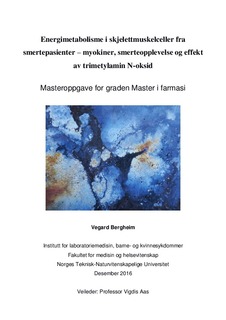| dc.description.abstract | Background: Dysfunctional energy metabolism in skeletal muscle is associated with obesity, metabolic syndrome, type 2 diabetes (T2DM) and cardiovascular diseases (CVD). Detrimental changes in energy metabolism are result of a holistic and multi-factorial cause including, but not limited to physical inactivity and composition of food intake and its impact on the microbiota. Trimethylamine N-oxide (TMAO) is a product of dietary choices, intestinal microbiota and liver capacity. TMAO has been shown to predict CVD’s like heart attack and stroke by a suspected proatherogenic activity, but is also associated with T2DM. Low back pain (LBP) is also a widespread problem related to a modern lifestyle. Some cytokines hypothesized to be involved in mediating the inflammatory state that leads to pain, can also be defined as myokines regarding their secretion from skeletal muscle where many are known to have impact on energy metabolism. Based on this, relations between energy metabolism, myokine expression, experience of pain and effects of TMAO were examined in skeletal muscle cells from patients suffering from low back pain.
Methods: Satellite cells were isolated from biopsies of two groups, musculus spinae erector (LBPgroup) and m. obliquus internus abdominis (healthy individuals). The cells were cultured, proliferated and differentiated into multinuclear myotubes. During differentiation, the cells were pretreated with [TMAO] in the range of 1 µM – 100 mM over 0-96 hours. Glucose and lipid metabolism were studied using radiolabeled D-[14C(U)] glucose and [1-14 C]oleic acid, respectively. Data on self-reported experience of pain were gathered from a questionnaire answered by patients in prior to surgical intervention for treatment of LBP. Relations between myokine secretion, energy metabolism, self-reported experience of pain, and patient data was studied in the group of LBP. Myokine secretion of fractalkine (CX3CL1), interleukine-6 (IL-6), IL-8 (CXCL8), MCP-1 (CCL2), SDF-1 (CXCL12) and GROα (CXCL1) were measured with multiplexed immunoassay, while gene expression of IL-6 and IL-8 were studied using quantitative polymerase chain reaction.
Results/conclusion: TMAO had minimal effects on glucose and lipid metabolism, and no differences by TMAO-effects were found between the groups of LBP and healthy individuals. The degree of experienced LBP correlated with suppressibility, a parameter describing metabolic flexibility. Higher degrees of pain were found to have negative impact on the uptake and oxidation of glucose, and uptake of oleic acid was increased in the LBP group in comparison to the group of healthy individuals. Skeletal muscle cells from the group of LBP secreted all the tested myokines, but none correlated with degree of experienced LBP. However, fractalkine (CX3CL1) correlated to body mass index (BMI) in the group of LBP, where higher BMI correlated with lower levels of fractalkine. | nb_NO |
